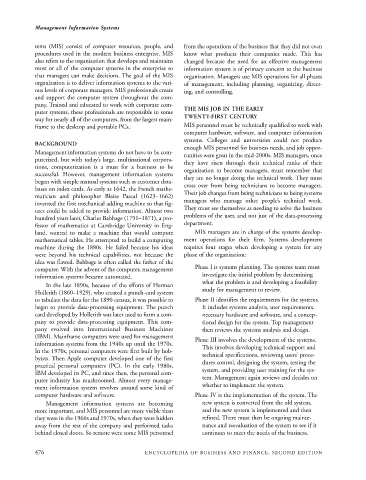Page 499 - Encyclopedia of Business and Finance
P. 499
eobf_M 7/5/06 3:15 PM Page 476
Management Information Systems
tems (MIS) consist of computer resources, people, and from the operations of the business that they did not even
procedures used in the modern business enterprise. MIS know what products their companies made. This has
also refers to the organization that develops and maintains changed because the need for an effective management
most or all of the computer systems in the enterprise so information system is of primary concern to the business
that managers can make decisions. The goal of the MIS organization. Managers use MIS operations for all phases
organization is to deliver information systems to the vari- of management, including planning, organizing, direct-
ous levels of corporate managers. MIS professionals create ing, and controlling.
and support the computer system throughout the com-
pany. Trained and educated to work with corporate com-
THE MIS JOB IN THE EARLY
puter systems, these professionals are responsible in some
TWENTY-FIRST CENTURY
way for nearly all of the computers, from the largest main-
frame to the desktop and portable PCs. MIS personnel must be technically qualified to work with
computer hardware, software, and computer information
systems. Colleges and universities could not produce
BACKGROUND
enough MIS personnel for business needs, and job oppor-
Management information systems do not have to be com-
tunities were great in the mid-2000s. MIS managers, once
puterized, but with today’s large, multinational corpora- they have risen through their technical ranks of their
tions, computerization is a must for a business to be organization to become managers, must remember that
successful. However, management information systems they are no longer doing the technical work. They must
began with simple manual systems such as customer data-
bases on index cards. As early as 1642, the French mathe- cross over from being technicians to become managers.
matician and philosopher Blaise Pascal (1623–1662) Their job changes from being technicians to being systems
managers who manage other people’s technical work.
invented the first mechanical adding machine so that fig-
They must see themselves as needing to solve the business
ures could be added to provide information. Almost two
problems of the user, and not just of the data-processing
hundred years later, Charles Babbage (1791–1871), a pro-
department.
fessor of mathematics at Cambridge University in Eng-
land, wanted to make a machine that would compute MIS managers are in charge of the systems develop-
mathematical tables. He attempted to build a computing ment operations for their firm. Systems development
machine during the 1880s. He failed because his ideas requires four stages when developing a system for any
were beyond his technical capabilities, not because the phase of the organization:
idea was flawed. Babbage is often called the father of the
computer. With the advent of the computer, management Phase I is systems planning. The systems team must
information systems became automated. investigate the initial problem by determining
what the problem is and developing a feasibility
In the late 1890s, because of the efforts of Herman
Hollerith (1860–1929), who created a punch-card system study for management to review.
to tabulate the data for the 1890 census, it was possible to Phase II identifies the requirements for the systems.
begin to provide data-processing equipment. The punch It includes systems analysis, user requirements,
card developed by Hollerith was later used to form a com- necessary hardware and software, and a concep-
pany to provide data-processing equipment. This com- tional design for the system. Top management
pany evolved into International Business Machines then reviews the systems analysis and design.
(IBM). Mainframe computers were used for management Phase III involves the development of the systems.
information systems from the 1940s up until the 1970s.
This involves developing technical support and
In the 1970s, personal computers were first built by hob- technical specifications, reviewing users’ proce-
byists. Then Apple computer developed one of the first
dures control, designing the system, testing the
practical personal computers (PC). In the early 1980s,
IBM developed its PC, and since then, the personal com- system, and providing user training for the sys-
puter industry has mushroomed. Almost every manage- tem. Management again reviews and decides on
ment information system revolves around some kind of whether to implement the system.
computer hardware and software. Phase IV is the implementation of the system. The
Management information systems are becoming new system is converted from the old system,
more important, and MIS personnel are more visible than and the new system is implemented and then
they were in the 1960s and 1970s, when they were hidden refined. There must then be ongoing mainte-
away from the rest of the company and performed tasks nance and reevaluation of the system to see if it
behind closed doors. So remote were some MIS personnel continues to meet the needs of the business.
476 ENCYCLOPEDIA OF BUSINESS AND FINANCE, SECOND EDITION

